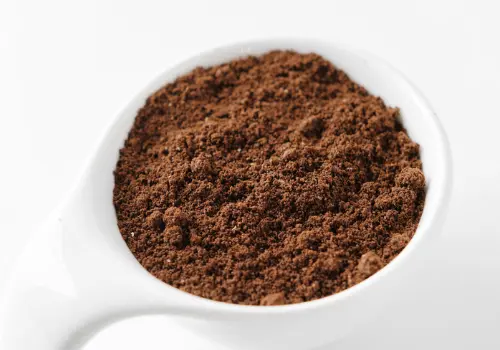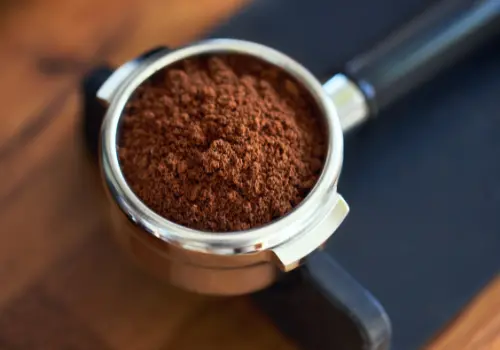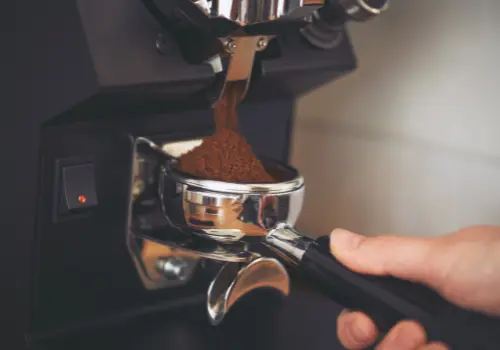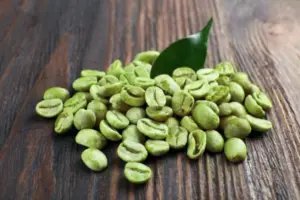How To Grind Coffee For Espresso; A Barista Weighs In
Disclosure: This post contains affiliate links and I may earn a small commission (at no extra cost to you) if you click through and make a purchase. Thanks in advance – I really appreciate it!
It’s the one question that I get asked all the time – “What is the perfect grind size for espresso?” Grinding coffee for espresso takes some skill. The size of the grind will determine the flavor of your cup, for better or for worse. Thus, grinding correctly is critical to creating your ideal espresso flavor.
Key Takeaways:
How to grind coffee for espresso?
Espresso brewing calls for a fine coffee grind size. In terms of consistency, it’s a little finer than table salt. Fine grind is required because of the short time the coffee grind comes in contact with water. Pressure builds up in the espresso maker which forces the water through the fine grinds.

Getting the perfect grind size for espresso is the most complex variable in the espresso-making process. In this article, we will give you some great tips on how to get the right grind size for your espresso.
The Perfect Grind Size For Espresso
Espresso is a lot of fun but it’s also immensely frustrating especially when you are just starting out and I would say this variable is by far the most frustrating of all of them to work with.
So let’s say you make a grind setting change, going a little bit finer on your grinder in doing so you will expose a lot more surface area of the ground coffee.
If you think about cutting an apple into big pieces it’s not much surface area, but if you dice it down to tiny pieces you will expose a lot more of the inside of the apple and the same is true with the coffee bean.
So far, that’s very good news, more surface area is very useful for extracting more coffee flavor.
But when you change the surface area you also change the way the coffee grounds interconnect with each other and when you tamp them down in your puck of coffee the finer the pieces are the better they fit together and harder it is for the water to flow through them.
This will increase the contact time between the water and coffee, so when you make this one change to the surface area, and it impacts the flow rate and contact time as well. Which can be again – quite frustrating!
But without grinding finely enough you cant do the extraction work that you need to to get all the good flavor out using only a little bit of water as that’s the nature of espresso. You want to use just a little bit of water to have a strong, concentrated, thick, delicious, gooey, and sweet espresso at the end of it.
So, at first use a fine-grind coffee size to get close to a good-tasting espresso. If things are dominatingly sour you need to adjust your grinder settings and grind a little bit finer, if you find that the taste of your espresso is bitter or harsh, or if your getting a lot of channeling then you may grind your beans a little bit coarser.

How Do You Know if Espresso Grind is Good?
To make an espresso use a fine coffee grind from dark roasted coffee beans. In texture, it is a bit finer than the table salt.
The espresso brewing process is very short. When the water flows through the fine coffee grounds, it’s able to extract maximum flavor in a little amount of time.
But, how to know if the espresso grind is good?
Take a small pinch of coffee grounds between your thumb and finger, then separate your fingers. If the coffee fails to clump together, it’s too coarse, and if it leaves an outline on your fingerprint, it’s too fine. Finely ground coffee that clumps together on your finger is perfect for espresso.
How Does Grind Size Affect Espresso?
The size of the coffee grind will determine how much espresso is actually extracted during the brewing process. Hot water flows through the grinds to extract the coffee flavor. The size of the grind will determine how much flavor the water is able to pull out.
If the grind is too coarse, you usually won’t get enough flavor from the coffee. You’ll end up with a sour and acidic cup of espresso. This is referred to as “under extraction” since the water isn’t able to contact enough of the coffee to pull out a strong flavor.
On the other hand, if the grind is too fine, you could have an “over-extraction”, which leads to an overwhelming and bitter espresso flavor. In this case, the water is in contact with too much ground coffee in too short a time period.
Can You Grind Any Coffee for Espresso?
You can grind any dark roasted coffee beans to a fine grind size to make espresso. Fine grind creates a large surface area that allows coffee flavors to impart into the hot water. Fine grind is smooth to touch but it feels like salt or sugar when you rub it with your fingers.
Most espresso grinders will allow you to adjust this size setting until you find a grind that works best for your bean variety and preferences. While you can use a simple hand-operated coffee grinder, this will usually result in a low-quality, inconsistent espresso.
If your coffee grind is too large, the brewing process will be under-extracted, meaning the brew didn’t capture the full flavor of the grinds. Usually, the drink will taste quite sour and watered down.
On the other hand, if the grind is too small, you’ll have an over-extracted cup of espresso and it will most likely be bitter. Small coffee grounds result in a strong cup of coffee and large grounds make it watered down.

Burr Grinders Vs Blade Grinders For Espresso
Espresso grind needs to be a fine grain and Burr grinders are the best grinders to grind coffee beans for espresso.
Stay away from blade grinders when you are grinding coffee for espresso. They are far different from burr grinders.
A blade grinder works like a blender. Blades in the canister spin quickly to chop up the coffee beans.
This often creates an inconsistent grind, which is bad news for your coffee. Grind inconsistency means that some beans are over-extracted while others are under-extracted, often causing a sour and bitter taste in coffee.
Blade grinders also heat the ground coffee, changing the final flavor when brewing is complete. Stay away from them when grinding coffee for espresso.
Burr grinders are far more versatile and precise when you compare them with blade grinders.
These grinders will enable you to make precise grinds without any issues. Burr grinders feature a couple of toothed discs and the coffee beans fall between them.
You can preset the discs according to the fineness of the grounds that you require based on the brewing method of your choice. Therefore, you will be able to get the perfect results according to your needs.
What Grinder Settings To Use To Grind Beans For Espresso?
Below is a table with grinder settings for the popular burr grinders that I assume most people will have in their kitchens. My apologies if you do not find your burr grinder on this list. Please refer to the user manual of your grinder to know the setting for espresso grinds.
| Grinders | Grind Setting |
|---|---|
| Baratza Encore | 4 – 9 |
| Baratza Virtuoso | 4 – 9 |
| Baratza Vario | 1 – 2 |
| Capresso Infinity | 2 – 4 |
| Cuisinart Supreme Grind | 2 – 4 |
| Bodum Bistro | 1 – 3 |
| OXO Brew Burr Grinder | 1 – 3 |
| Hario V60 | 4 – 10 |
| KRUPS Burr Grinder | 2 – 4 |
How To Grind Coffee Beans For Espresso With A Grinder?
Coffee should be ground just before brewing because aromas are released during the grinding process.
Any time you’ve smelled wonderful coffee in a cafe or the coffee aisle of the grocery store, it’s from aromas that are released as the beans are broken up.
These aromas are full of flavor. In fact, they’re some of the most flavorful compounds in coffee.
These aromas can greatly add to a cup’s flavors, but they disappear quickly. The only way to capture them in a cup is by brewing immediately after grinding so that the aromas enter the brew’s water instead of the air.
Step 1: Check Your Coffee
Make sure that your coffee is a dark roast coffee bean. Espresso coffee needs to be a dark roast. You will enjoy all the smooth finishes and acidic taste in your espresso from the darker roast.
Step 2: Set Your Burr Grinder
It’s important to set your burr grinder to the correct setting. Most burr grinders will have a setting for espresso grinds. For the Baratza Encore and the Virtuoso, the best setting for espresso will be either four or five.
Step 3: Place The Bean In The Hopper.
Measure the coffee beans and place them in the hopper. Regardless of how many beans you used, one espresso shot takes roughly 0.25 ounces (7 grams) of coffee grounds, enough to fill the filter on your espresso machine and add a small mound on top.
Step 4: Turn Your Burr Grinder On
Turn your burr grinder on and let it run its cycle. You’ll get your ground coffee in the container at the bottom.
How To Grind Coffee Beans for Espresso Without a Grinder?
If you find yourself in a situation where you don’t have access to a coffee grinder, don’t panic. You can still enjoy a delicious cup of espresso, from fresh grounds.
With some simple kitchen tools, you can easily grind coffee beans for espresso and replicate the texture and consistency produced by a grinder.
You can grind coffee beans for espresso without a grinder using a blender or a food processor. You can also use a rolling pin, hammer, mortar and pestle, hand mincer, or a garlic press to grind coffee beans. With each of these methods, you can make the grind as fine or coarse as you want.

How To Make Espresso Using An Espresso Machine
To make true Italian espresso at home that rivals what you’d get in a coffee shop, you need an espresso machine. These range from manual machines (where you tamp and brew everything yourself) to automatic and capsule machines.
Step 1: Grind and Measure Your Coffee
Using dark roast coffee beans and a quality grinder, grind enough beans to make one or two espresso shots. Your grounds should be powdery and fine.
An average single espresso shot will require between 6 and 8 grams of coffee grounds, although this can be adjusted up or down.
For precision, it’s best to use a scale to confirm that you’re dosing each shot (that is, measuring out the coffee grounds) correctly — just make sure to tare out the portafilter first.
Step 2: Distribute and Tamp Down the Grinds
Once you have an even amount of grounds in your portafilter that you’re happy with, distribute the grounds evenly with a finger, place the portafilter on the countertop or other flat surface, and then use the tamper to tamp down on the grounds. You’ll then have a compact disk of espresso in the portafilter.
Step 3: Pull Your Shot
Run the machine briefly without a portafilter in place to purge the group head (the nozzle where you insert the portafilter). Now lock that portafilter in the machine, keep a vessel underneath, and start your shot.
The espresso should be ready after 25 to 30 seconds, but it will take practice with your specific machine and lots of taste tests to achieve shots to your liking.
The espresso shouldn’t be too light or dark in color, shouldn’t taste too acidic or too bitter, and should have a fine layer of crema on top.

Amit Gupta
Hi, my name is Amit Gupta, and I am the owner and contributor at Cafeish. My obsession with coffee started when I received my first French press as a gift almost ten years ago. Since then, my love of coffee – and the number of coffee gadgets I own – has grown considerably.
Most Popular
ABOUT US
We are a team of coffee affcianados with experience and expertise in making world renowned coffee. In fact, preparing the best coffee ever with a fluffy top reminds us of magic, with secrets of how to achieve each particular effect. Making coffee is not our only hobby, we always keep our ears open as to what’s happening around and what scientists and manufacturers produce for consumers. It’s not an easy task to do – it’s rather time consuming. Hence, Caféish website was launched.
LEGAL DISCLAIMER
Caféish is a participant in the Amazon Services LLC Associates Program, an affiliate advertising program designed to provide a means for sites to earn advertising fees by advertising and linking to Amazon.com. Caféish also participates in affiliate programs with Clickbank and other sites. Caféish is compensated for referring traffic and business to these companies.




